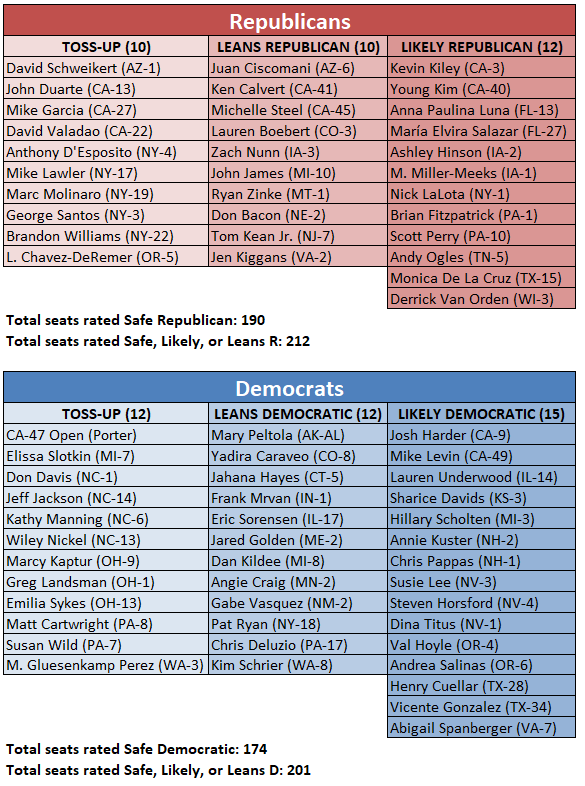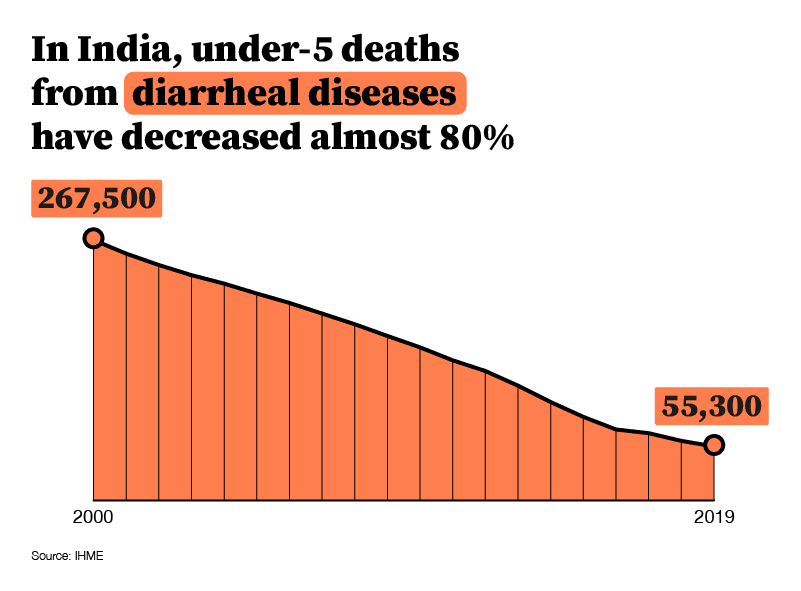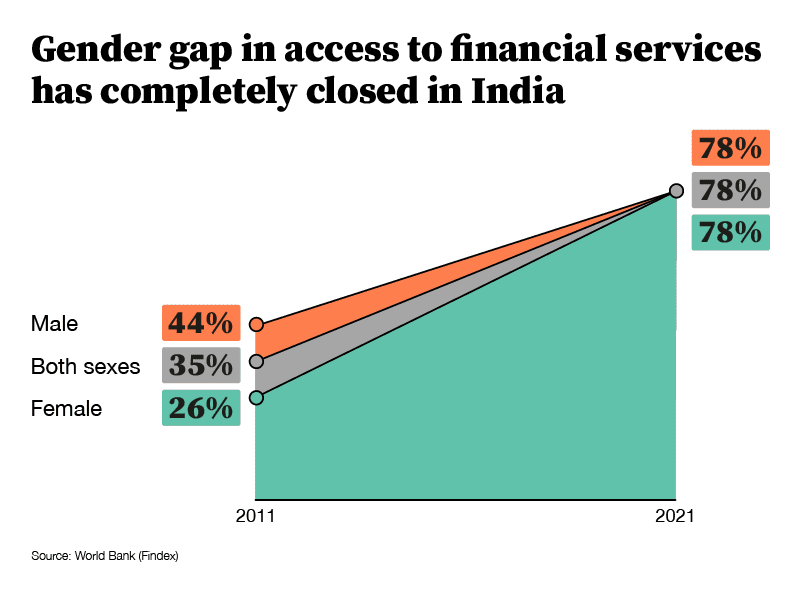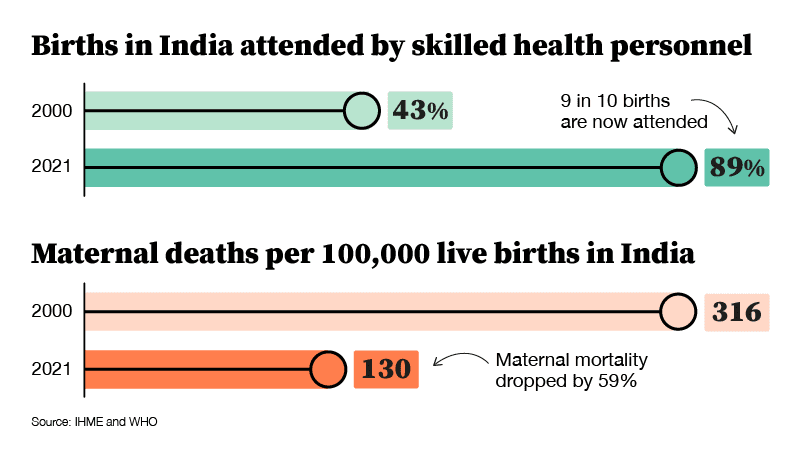|
|
|
|
|
|
|
|
|
|
|
|
|
|
|
|
|
|
|
|
|
|
|
|
5. WHO RUN THE WORLD? CHRIS COONS: The Democratic Delaware senator has emerged as a critical face of the Biden administration and the U.S. on the world stage, Alex Ward reports from Munich, where everybody wants to talk to Coons. World leaders see Coons as not only a close Biden ally on policy and shadow secretary of State but a representative of “Biden, the man,” Alex writes. In Germany, his “message was simple: Help Ukraine without risking America’s military readiness for future fights — namely should China invade Taiwan — and don’t plunge the U.S. into another foreign war.” 6. WHO RUN THE HOUSE GOP? RUSS VOUGHT: The former Trump aide “has emerged as one of the central voices shaping the looming showdown over federal spending and the national debt,” WaPo’s Jeff Stein, Josh Dawsey and Isaac Arnsdorf write. Vought is supplying Republicans with a “seemingly inexhaustible stream of advice” as they haggle with Dems over raising the debt limit. But just how pervasive is Vought’s influence? “Several Republican lawmakers and staffers privately acknowledged talking to Vought at least once a week. Earlier this month, he briefed about four dozen GOP senators over lunch in the Capitol, according to Sen. RICK SCOTT (R-Fla.), who said it was at least the third time he had heard Vought’s pitch for dealing with the debt limit.” 7. THE LAST FRONTIER: “Inside the Hunt for U.F.O.s at the End of the World,” by NYT’s Katie Rogers in Deadhorse, Alaska: “The good people of Deadhorse notwithstanding, many of us still had a lot of questions. For a nation that has been riveted by this saga since the aerial assaults on mysterious objects began — Pop! Pop! Pop! — the end felt incomplete. Were aliens involved? (No, says the White House.) Surveillance devices of mysterious provenance? (No, says the White House.) Hobby balloons? (We may never know, says the White House.) But of course, this is America. When was the last time we let anything go?” 8. WHO’S AT DEFAULT? “Debt-Ceiling Standoff Prompts Backup Plans, but They Face Hurdles Too,” by WSJ’s Andrew Duehren and Siobhan Hughes: “There is no clear escape hatch to avoid default if Congress doesn’t pass legislation raising the debt ceiling. Potential alternatives to addressing the borrowing limit—from simply ignoring it, to minting a trillion-dollar coin, to prioritizing certain payments—all face hurdles, underlining doubts about any fallback plan if Democrats and Republicans fail to reach a deal by this summer.” 9. THE PERSISTENT PANDEMIC: “Why the U.S. Covid-19 Death Toll Is Still Rising,” by WSJ’s Jon Kamp: “The U.S., which recently topped 1.1 million Covid-19 deaths since the pandemic began, continues to record several hundred more each day, death-certificate data show. The people who are dying remain old, often with underlying h |
| ||||||||||||||||||||||||||||||||||||||||||||||||||||||
|
| Feb 23, 2023, 3:09 AM (3 days ago) |   | ||
| ||||
 | |||
| |||
KEY POINTS FROM THIS ARTICLE-- The overall battle for House control in 2024 starts as a Toss-up. -- Relatively similar numbers of Democratic and Republican seats start in the most competitive Toss-up and Leans categories, although Republicans start with a few more targets in large part because of the likelihood that they will benefit from redistricting in North Carolina and Ohio. -- Big blue states California and New York, where Republicans have made key gains over the past couple of cycles, loom large as Democrats plot a path back to the House majority. The House at the starting gateAfter consecutive election cycles in which the favored side won the House, but by significantly smaller margins than many (including us) expected, we want to be clear from the start how we’re viewing the House this cycle: The race for the majority begins as a Toss-up. While midterms, and not presidential years, much more frequently serve as the engine of change in the House -- 10 of the last 12 shifts in power came in midterm cycles -- it is also rare for a midterm to produce such a small majority for the winning side as last year’s did. The Republicans won a 222-213 edge last year, which is just 4 seats above the magic number of 218. That is the smallest number of seats won by the winning side in a midterm since the 1942 election, when Republicans won the national popular vote for House but were unable to break the Democratic majority (Democrats won 222 seats to the Republicans’ 209, with the remaining few seats going to third parties). In the years since then, every other majority won in a midterm was at or above 230 seats except for the majorities that Republicans won in 1998 (223) and 2002 (229). Those happened to be a pair of strong midterm cycles for the incumbent president, Bill Clinton’s Democrats in the former and George W. Bush’s Republicans in the latter. This past midterm will also go down as a good one for President Biden’s Democrats, and while they still lost the House, they kept their losses to such a manageable number that they put themselves in striking distance of winning the House majority this cycle. That’s the same thing Republicans did in their impressive albeit losing House effort in 2020 -- keeping it close and setting themselves up for the following election. The bottom line is that parties typically build themselves a bigger buffer in the midterm than Republicans did last year, which likely contributes to the history that the House has not flipped in a presidential year since 1952. Such streaks are noteworthy but are often made to be broken. Speaking of 1952, which represented 1 of just 2 House victories for Republicans from the Great Depression all the way through the Republican Revolution of 1994 (1946 was the other), Republicans got an assist that year in redistricting. Following the 1950 census, Republicans in California and New York engaged in what the legendary congressional scholar David Mayhew described as “ingenious cartographic efforts” in redistricting that contributed to Republicans flipping the House. More than 7 decades later, redistricting may also prove decisive in the House -- potentially helping Republicans hold on to the majority and keeping the long streak of the House not flipping in presidential years alive. Meanwhile, those key states of California and New York again loom large in this cycle’s battle for the House. With that in mind, Table 1 shows our initial House ratings for the 2024 cycle. A total of 44 seats -- 20 currently held by Republicans and 24 held by Democrats -- begin in the most competitive categories (Toss-up or Leans). That’s just 10% of the total seats in the House. Table 1: Crystal Ball House ratings In no particular order, let’s go through the highlights: -- Both North Carolina and Ohio are poised to have new congressional maps this cycle. There will be time to go through the contortions and specifics later, but the overall point is this: State Supreme Courts in both states constrained the maps that the GOP wanted to impose in both states last cycle, and conservatives scored victories in key state Supreme Court races in both states last November, which should give the Republicans a freer hand to operate in both states. New GOP gerrymanders could threaten up to 3 Democratic seats in Ohio and 4 in North Carolina -- this is why we are starting all of those potential Republican targets in the Toss-up column for now. This reflects the Democratic exposure in these 2 states while also conveying uncertainty about what is actually going to happen. These potential redistricting losses -- not all of which are guaranteed to occur -- make up the majority of the Democratic Toss-up column. -- There are a number of other unresolved court cases that could impact redistricting, potentially in favor of Democrats in at least some places. CNN’s Ron Brownstein recently had a good summation. At the moment, the only states where the anticipation of future redistricting changes impacts our ratings are, again, North Carolina and Ohio. If and when other legal developments increase the likelihood of new maps in other states, we will adjust our ratings as warranted. -- We are assuming, for the sake of these ratings, that Rep. Elissa Slotkin (D, MI-7), a proven incumbent in a marginal Lansing-based seat, ends up running for U.S. Senate (she is not an announced candidate, but observers on both sides of the aisle expect her to run). So her district starts as a Toss-up; we will move her district to Leans Democratic if she unexpectedly runs for reelection instead. Also starting in the Toss-up category is CA-47 in Southern California, which Rep. Katie Porter (D) is leaving behind as she pursues an open-seat Senate run of her own. The district voted for Joe Biden by 11 points, which suggests that it should not be a Toss-up. But CA-47 is not as blue down the ballot -- as Porter’s 3.5-point victory last cycle suggests -- and Republicans have scored some surprising successes in similar kinds of districts in California recently. One other wrinkle is the possibility of a strange outcome in the state’s top-2 primary; all candidates run together on the same ballot in the primary, with the top 2 finishers advancing to the general election regardless of party. Although such a scenario has not come to pass in a truly competitive seat since the 2012 cycle, Democrats sometimes worry about 2 Republicans advancing to a general election in a district like this. It may also be the case that Republicans have a competitive presidential primary going on in California at the time of the primary while Democrats do not, which could impact turnout. Democrats already have credible options running to replace Porter, although the departing incumbent is an exceptionally strong fundraiser, which is helpful in a district covered by the expensive Los Angeles media market. So this is all enough for us to start CA-47 as a Toss-up. -- Beyond CA-47, Democrats don’t have much defending to do in California, as their other seats all start as either Safe Democratic or (in a couple of instances) Likely Democratic. On the other side of the aisle, Republicans are defending a trio of incumbents in double-digit Biden seats: Reps. John Duarte (R, CA-13) and David Valadao (R, CA-22) in the Central Valley, and Mike Garcia (R, CA-27) in Southern California. They all start as Toss-ups. Garcia in particular benefited from a weak opponent, former state Assemblywoman Christy Smith (D), in his victories in 2020 and 2022. On Wednesday morning, former Virgin Galactic CEO George Whitesides (D) announced he will challenge Garcia, and some Democrats are optimistic about his candidacy. -- New York, where Republicans enjoyed something of a localized “Red Wave,” features 5 new incumbents who start in the Toss-up column, including the now-infamous Rep. George Santos (R, NY-3), with his tsunami of scandals and bogus resume. If Santos actually advanced to the general election next November, he would be a significant underdog. But perhaps he resigns before then, resetting the table for a special election, or otherwise retires or loses in a primary. In the other key Biden-won seats held by Republicans, Democrats will hope that the presidential tide helps wash away newly-elected Reps. Anthony D'Esposito (R, NY-4), Mike Lawler (R, NY-17), Marc Molinaro (R, NY-19), and Brandon Williams (R, NY-22), although Democratic recruitment will also be vital in these races. D’Esposito, who holds the bluest seat held by any Republican, won the suburban Long Island district directly south of the one that Santos holds, while the others won districts north of New York City. -- If Democrats win back the House, California and New York will likely play a huge role in the outcome -- just like they did way back in 1952, the last time the House flipped in a presidential year. But Democrats often worry about these big, blue states because they are “orphan” states -- they are uncompetitive at the statewide level for president and Senate, so there’s not a big statewide mobilization effort to drive turnout in competitive congressional districts. House Majority PAC, the heavyweight outside spending group that backs Democratic candidates, announced Wednesday it is planning a dedicated $45 million fund to target New York House seats, a clear acknowledgement of the state’s importance to the Democratic path to the majority as well as the need for Democrats to spend extensively there. -- Out on the West Coast, newly-elected Reps. Marie Gluesenkamp Perez (D, WA-3) and Lori Chavez-DeRemer (R, OR-5) benefited from flawed general election opponents who toppled incumbents in primaries. Both rank among the most vulnerable incumbents for their respective sides. -- Eastern Pennsylvania, the native region of President Joe Biden, is the site of a pair of key, Toss-up defensive assignments for Democrats: Reps. Matt Cartwright (D, PA-8) in the Scranton area and Susan Wild (D, PA-7) in the Lehigh Valley. -- Reps. Mary Peltola (D, AK-AL) and Jared Golden (D, ME-2) hold the 2 most Republican districts held by any Democrat. But their strong local brands, paired with ranked-choice voting systems that Republicans have yet to master, give each an edge to start. -- Rep. Lauren Boebert (R, CO-3), an in-your-face conservative who only barely won in a clearly GOP-leaning district in western Colorado, has not moderated her behavior at all in the aftermath of her near-loss. But observers on both sides of the aisle think she should be favored anyway because a more engaged and larger 2024 presidential electorate could help her stabilize her vote. This is something we sometimes hear from operatives: Near-miss upsets can occur precisely because a race isn’t heavily engaged with national money, perhaps lulling an incumbent (and maybe even voters themselves) into a false sense of security. -- The Democratic seats in Nevada, New Hampshire, Oregon, and Texas that start in the Likely Democratic category are all ones that Republicans competed for to at least some degree in 2022 but failed to capture. They are all districts where President Biden performed better than he did nationally in 2020, and several are probably less attractive targets for Republicans than they were last cycle. That Democrats held onto all 3 of their Nevada seats last year by fairly clear margins (roughly 4-5 points) despite losing the state’s governorship shows the efficacy of the state’s Democratic gerrymander. The Republicans would have to win the state for president by several points just to carry any of those districts, something that seems unlikely in such a closely-divided state. So we view all 3 as clear favorites to start. -- In the respective Leans columns, we gave the benefit of the doubt to a handful of incumbents, including Reps. Don Bacon (R, NE-2) and Tom Kean Jr. (R, NJ-7) on the GOP side and Reps. Yadira Caraveo (D, CO-8) and Gabe Vasquez (D, NM-2) on the Democratic. The former pair will likely have to create some distance between themselves and the GOP presidential nominee in their blue-trending districts, but Bacon has shown the ability to do that and Kean may be able to after knocking off Tom Malinowski (D) last cycle. Caraveo and Vasquez overcame a tricky political environment to each snatch surprising albeit narrow victories. With Democrats likely to carry their districts for president again, we give them an edge to start. We also gave a small edge to first-term Rep. Juan Ciscomani (R, AZ-6), who won an evenly-divided Tucson-area seat last cycle, but not to his fellow Arizona Republican, Rep. David Schweikert (R, AZ-1) in the Phoenix area. Ciscomani’s district is slightly better for Republicans than Schweikert’s, and the latter has seen his performance sag under the weight of redistricting, realignment, and ethics violations. We may be splitting hairs to rate them differently, but we are also in the splitting hairs business. ConclusionSources on both sides of the aisle generally believe that the House playing field is not going to be that large. Part of it is that redistricting slightly reduced the number of truly competitive districts, and the North Carolina and Ohio maps could chip away at that number a little further. But Republicans also probably will not be casting as wide of a net as they did in 2022, as they came up empty in many districts where Biden did better than he did nationally. That includes arguably red-trending but still blue districts like the ones held by Reps. Frank Mrvan (D, IN-1), Henry Cuellar (D, TX-28), and Vicente Gonzalez (D, TX-34). Republicans were hoping that another turn of the realigning wheel in these places after Donald Trump made them more competitive in 2016 and/or 2020 would flip them red in 2022, but that didn’t happen. So Republicans may not push as hard in these districts as they did last time. Among the Republican advantages this cycle are that the likeliest redistricting changes, in North Carolina and Ohio, should help Republicans to at least some extent. Among the Democratic advantages are that they have more Biden-district Republicans to target (18) than Republicans have Trump-district Democrats to target (5). The correlation between presidential and House results has been growing over time, to the point where there is not nearly as much daylight between the results for president and the results for House in an average district as there once was. But there is still daylight, and those differences may ultimately decide the majority. Our overall ratings show 212 seats rated Safe, Likely, or Leans Republican, 201 rated Safe, Likely, or Leans Democratic, and 22 Toss-ups. Splitting the Toss-ups evenly, 11-11, would result in a net GOP gain of a single seat. Democrats need to net 5 seats to win the majority. Again, we think this is reflective of an overall Toss-up House race to start. |
February 20, 2023
We awoke this morning to news that President Joe Biden was in Kyiv, Ukraine, where he pledged “our unwavering and unflagging commitment to Ukraine’s democracy, sovereignty, and territorial integrity.” Air raid sirens blared as Biden and Ukraine president Volodymyr Zelensky walked through the streets during the U.S. president’s five-hour stay.
As National Security Advisor Jake Sullivan told reporters, Biden’s visit was the first time a U.S. president has visited “the capital of a country at war where the United States military does not control the critical infrastructure”…in other words, an active war zone. Biden traveled in a special mission plane from Germany to Poland, then took a train from Poland to Kyiv. To make sure there would be no attacks, the U.S. notified the Russians that Biden would be in Kyiv, but a Russian MiG 30 flew from Belarus during Biden’s visit, triggering air raid sirens.
According to Sullivan, Biden felt it was important to visit Kyiv at the anniversary of the 2022 Russian invasion. The image of Biden and Zelensky standing together sent a message to Russian president Vladimir Putin, as David Rothkopf put it in the Daily Beast: “I am here in Kyiv and you are not. You not only did not take Kyiv in days as some predicted, but your attack was rebuffed. Your army suffered a humiliating defeat from which it has not recovered.”
Just under a year ago, the global equation looked very different. On February 4, 2022, Chinese president Xi Jinping hosted Russian president Vladimir Putin on the opening day of the Winter Olympics. The two men pledged to work together in a partnership with “no limits” in a transparent attempt to counter U.S. global leadership and assert a new international order based on their own authoritarian systems.
At the time, Russia was massing troops on its border with Ukraine but fervently denied it was planning to invade. On February 24, 2022, Russian tanks rolled across the border and Russian planes covered them in the air. Biden remembered that Zelensky called him and said he could hear the explosions as they spoke. “I’ll never forget that,” Biden said. “The world was about to change.” When Biden asked what he could do to help, Zelensky said: “Gather the leaders of the world. Ask them to support Ukraine.”
And over 50 nations stepped up to make sure the rules-based international order in place since World War II, which prevents one country from attacking another, held. Those backing Ukraine against Russian aggression have squeezed Russia with economic sanctions and supported Ukraine with military and humanitarian aid. As Biden said today, standing next to Zelensky: “Kyiv stands and Ukraine stands. Democracy stands. The Americans stand with you, and the world stands with you.”
Biden pledged another $460 million in aid to Ukraine, emphasizing that U.S. support for the country is bipartisan.
Biden mourned the cost Ukraine has had to bear, but championed its successes. “Russia’s aim was to wipe Ukraine off the map,” Biden said, but “Putin’s war of conquest is failing. Russia’s military has lost half its territory it once occupied. Young, talented Russians are fleeing by the tens of thousands, not wanting to come back to Russia. Not…just fleeing from the military, fleeing from Russia itself, because they see no future in their country. Russia’s economy is now a backwater, isolated and struggling.”
“Putin thought Ukraine was weak and the West was divided,” Biden said. He remembered telling Zelensky that Putin was “counting on us not sticking together. He was counting on the inability to keep NATO united. He was counting on us not to be able to bring in others on the side of Ukraine.” While Biden didn’t say it, Putin had reason to think those things: the four years of the Trump administration had seen the U.S. offending allies and threatening to pull out of NATO, the North Atlantic Treaty Organization that stands against Russian aggression.
“He thought he could outlast us,” Biden said. “I don’t think he’s thinking that right now…. [H]e’s just been plain wrong. Plain wrong.” A year later, Biden said, “We stand here together.”
“You and all Ukrainians…remind the world every single day what the meaning of the word ‘courage’ is—from all sectors of your economy, all walks of life. It’s astounding. Astounding.
You remind us that freedom is priceless; it’s worth fighting for for as long as it takes. And that’s how long we’re going to be with you, Mr. President: for as long as it takes.”
Zelensky answered, “We’ll do it.”
The world could stand behind Ukraine as it has because Biden and Secretary of State Antony Blinken have held a coalition together and presented a united front with Zelensky and allies and partners in defense of democracy.
In contrast today, Representative Marjorie Taylor Greene (R-GA) explicitly called for dividing the nation. She tweeted: “We need a national divorce. We need to separate by red states and blue states and shrink the federal government. Everyone I talk to says this.” For once I will spare you my usual lecture on how elite southern enslavers in the 1850s made this same argument because they resented the majority rule that threatened their ability to impose their will on their Black neighbors.
(I will note, though, that former representative Liz Cheney (R-WY) helpfully reviewed “some of the governing principles of America” for Greene, tweeting: “Our country is governed by the Constitution. You swore an oath to support and defend the Constitution. Secession is unconstitutional. No member of Congress should advocate secession, Marjorie.”)
What Greene had to say next is of more interest in this moment. The Munich Security Conference, the world’s largest gathering for international security discussions, has just reported that the Russian war on Ukraine is a war of authoritarianism on a rules-based international order. At that conference, Vice President Kamala Harris said the U.S. had determined that Russia has committed crimes against humanity and noted that the bipartisan U.S. delegation to the conference was the largest we have ever sent. The U.S. president has just entered a war zone to declare U.S. support for democracy and is now in Poland, where he will speak with the leaders of the nine countries that make up NATO’s eastern flank and will deliver a speech that Blinken has described as “very significant.”
In contrast, Greene echoed authoritarian leaders Viktor Orbán of Hungary and Putin himself when she called for splitting the nation over “the sick and disgusting woke culture issues shoved down our throats” and “the Democrat’s [sic] traitorous America Last policies.” Authoritarian leaders insist that the equality that underpins liberal democracy threatens traditional society because it means that LGBTQ people, women, and minorities should have the same rights as white men. Greene appears to be taking the same position.
Meanwhile, Fox News Channel personalities, including Tucker Carlson, are trying to spin Biden’s visit to Ukraine as proof that he doesn’t care about the train derailment in Ohio. Scholar of disinformation behavior Caroline Orr Bueno noted: “There’s a narrative being planted here; watch how support for Ukraine is framed as incompatible with US national interests.” She notes that a similar narrative in Canada argues that support for Ukraine hurts Canadian veterans.
A filing in Dominion Voter Systems’ lawsuit against FNC for defamation revealed last week that FNC personalities knowingly lied to their viewers about the legitimacy of the 2020 presidential election, acting as a propaganda outlet for Trump. This information is a handy backdrop for the news reported today by Mike Allen of Axios, who says that House speaker Kevin McCarthy (R-CA) has given to FNC host Carlson—who figured prominently in the election fraud lies—exclusive access to 41,000 hours of footage from the U.S. Capitol of the January 6, 2021, attempt to overturn the results of the 2020 presidential election. According to Allen, Carlson’s producers have already begun going through it to see what they can use on his show.
Putin is scheduled to address the Russian Federal Assembly tomorrow. Billboards in Russia proclaim: “Russia’s border ends nowhere,” but observers believe that he was hoping for a major victory on a battlefield in Ukraine before the speech. Instead, Russian forces have taken severe losses in their recent stalled offensive in eastern Ukraine near Bakhmut.
Biden’s speech in Poland will follow later in the day.
—
Notes:

https://www.reuters.com/world/
https://www.thedailybeast.com/
https://securityconference.


 @mtgreenee
@mtgreeneehttps://www.rferl.org/a/putin-


https://www.nytimes.com/2023/
https://www.axios.com/2023/02/
| ||||||||||||||||
| ||||||||||||||||
| ||||||||||||||||
| ||||||||||||||||
| ||||||||||||||||
| ||||||||||||||||
| ||||||||||||||||
| ||||||||||||||||
Before we start: Our colleague Ted Johnson has joined the Washington Post. I’m supposed to say that readers will miss him as much as we do, but that can’t possibly be true. Because while Bulwark readers loved Ted for his work, I got the privilege of knowing Ted as a guy I worked with every day. And he was one of the best colleagues I’ve ever had, anywhere. Generous, brilliant, kind, interesting. You couldn’t ask for a better guy. I miss him already. But at the same time, I’m incredibly proud of him. It’s crazy to realize that Ted’s not a writer by training—he was a math guy, of all things. He had an entire career in the military and is only a few years into the writing life. That’s what I would think about whenever I edited him: Holy crap. As good as this is, he’s going to keep getting better for another couple decades. Here’s an essay for Memorial Day that we all especially loved. So together we can mourn not having Ted at The Bulwark anymore. But also we can be thrilled that he got called up to the Bigs and we can look forward to reading him at the Washington Post. And I’m grateful that I got the chance to work with him. And grateful that we are able to publish such talent under The Bulwark banner for all to read. Love you, Ted. #Bulwark4Life Joe Biden: Still Doing Better Than You ThinkWhat's the argument against Biden 2024 again?
1. The BorderThe list of Biden administration debits is topped by:
All three of those are real problems that have occurred during Biden’s presidency. However:
And immigration? Here’s the headline from CATO’s Alex Nowrasteh: “Biden's New Border Plan Slashes Illegal Immigration.”
Will it matter? I don’t know. Republicans are going to keep saying that immigration at the border is a mess, even if that’s no longer true. Same way they’re going to keep talking about inflation even as inflation comes under control. Here’s Ron DeSantis doing it this weekend as a means to avoid taking a real position on Ukraine. The narrative doesn’t care about your facts. But it does seem worth noting that Biden continues to govern in a manner that isn’t perfect, but is reasonably effective and which addresses the real world problems that have nothing to do with gender-neutral Oompa Loompas.¹ I said this on The Next Level a couple weeks ago and I was joking—but also kind of not joking: I never would have guessed that the two most effective presidents of my lifetime would be Reagan and Biden. But here we are. 2. Old Man BidenThe story of how Biden’s trip to Kyiv happened is pretty interesting, just from a logistics perspective. The Washington Post has the story and the sequence goes like this:
I don’t know about you, but I’m exhausted just reading this. Heck, I have to fly to Dallas later this week—non-stop, 4 hours—and I’m dreading it. Biden did 22 hours of travel with the full planes, trains, and automobiles—and then pulled off the most consequential trip by an American president since . . . the Reykjavík Summit? And voters are going to keep saying that he’s too old to do the job of president. Again: Narrative, facts, etc. |




:quality(70)/cloudfront-eu-central-1.images.arcpublishing.com/thenational/WPKMRDJ7K5CFPOWAJLF2EXWMUM.jpeg)
:quality(70):focal(2657x2748:2667x2758)/cloudfront-eu-central-1.images.arcpublishing.com/thenational/YXF7J4K6OK4YPQ3RVADZOYW7XA.jpg)
:quality(70)/cloudfront-eu-central-1.images.arcpublishing.com/thenational/XOVWTPEPVVAAZHVYCS754DNUMI.jpg)
:quality(70)/cloudfront-eu-central-1.images.arcpublishing.com/thenational/NNCQYSQ6WBO6JQZUVL5QLHBWWE.jpg)






































